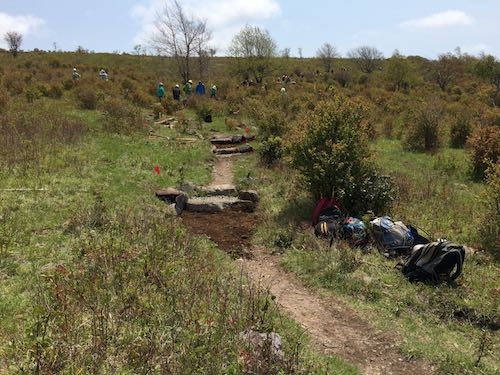Crow’s Nest: Another Busman’s Holiday
By Daniel Barringer, Preserve Manager
I had the privilege to spend a long weekend at the Appalachian Trail Days in Damascus, Virginia, and volunteer at “Kincora Hard Core,” an opportunity for hikers to give back to the trail that supports their feet for approximately 2,189 miles.
Current, past and future hikers congregate in Damascus to share experiences, update gear, and refresh themselves for the ongoing journey. The weekend is filled with lectures, music, great food, and camaraderie and serves as a reunion for hikers by class year (my wife Denise thru-hiked in 2006; we last attended Trail Days and Hard Core in 2009).
Kincora Hard Core, founded and organized by Bob Peoples of Kincora Hostel in Tennessee, was held this year in the Grayson Highlands in Virginia in partnership with the Appalachian Long Distance Hiking Association (ALDHA), the Appalachian Trail Conservancy (ATC), and the Mount Rogers Appalachian Trail Club. The Konnarock Trail Crew—a partnership of the ATC, the U.S. Forest Service, and the National Park Service—hosted the event and handled the logistics of moving 50+ volunteers into the backcountry for trail improvements, and then fed us wonderful food and gave us space to stay overnight at their base camp.
I was thrilled to participate in trail improvements on a section of trail that I hiked with Denise in 2006. The Grayson Highlands is a spectacular part of the Appalachian Mountains. I also felt lucky that we got to do some rock work—a task usually reserved for the most skilled and seasoned volunteers. We weren’t doing the hardest type—continuous staircases of huge rocks moved with block and tackle—but a series of short stone steps combined with locust wooden ones (“cribbing”), to offer improved footing and combine a braided mess of trails into just one stable treadway that will reduce erosion on this hillside that descends (for north bounders) to “The Scales” section.

The Konnarock Trail Crew takes safety seriously. In addition to a liability waiver and an extensive safety meeting beforehand, all participants must wear safety glasses and hard hats, and those breaking rocks must also wear shin guards.
While some gravel was imported to the site to use to set the rocks, crushed stone in the backcountry is generally made by taking large rocks and hitting them with a sledgehammer until they are, well, crushed. If you think moving buckets of stone (pictured above) is difficult I have to say it’s easier than making your own. And in the backcountry the only tools we used were pick/mattocks, pulaskis, iron rock bars, shovels, sledgehammers, buckets, and web baskets (so that several people together could carry a medium-sized rock).

The Konnarock Crew also prepped the project by selecting and moving some rocks closer to the trail before the volunteers arrived, and deciding exactly where the desired trail would go and how many steps were needed to make it easy to navigate. We just had to dig holes, place the steps, and fill in around them. But if you look carefully above you’ll also notice the scale of the project: the trails hooks to the left and then to the right; there are volunteers working on sections all the way up this hill. I’m particularly proud of these steps in the foreground that our crew placed.
While we might not have rock work in the immediate future at Crow’s Nest (which is also admittedly accessible “front-country”) I have a new appreciation for how volunteer crews can be organized, how trail design choices are made, how to leverage only human strength, and of various techniques to reduce erosion and shape hiker behavior.
